Quantitative Analysis of YouTube Channel Revenue: Case Study
VerifiedAdded on 2023/05/30
|9
|2090
|230
Case Study
AI Summary
This case study provides a comprehensive revenue analysis of the YouTube channel "To Catch a Cheater," which focuses on exposing unfaithful partners. The analysis includes an overview of the channel's background, content strategy, and data collected from SocialBlade regarding subscribers, total video views, and estimated revenue. The study identifies multiple revenue streams, including sponsorships, payments from clients for investigations, and Google AdSense revenue, and categorizes the channel's major expenses, such as payments to actors, equipment procurement, and staff salaries. Furthermore, the case study develops a rudimentary revenue model and explores the relationship between subscribers, total video views, and revenue through correlation analysis and linear modeling, ultimately aiming to forecast revenue based on these key variables. The document includes a revenue statement table outlining estimated monthly and annual income, expenses, and net profit, providing a detailed quantitative assessment of the channel's financial performance. Desklib offers this and many similar documents for students.
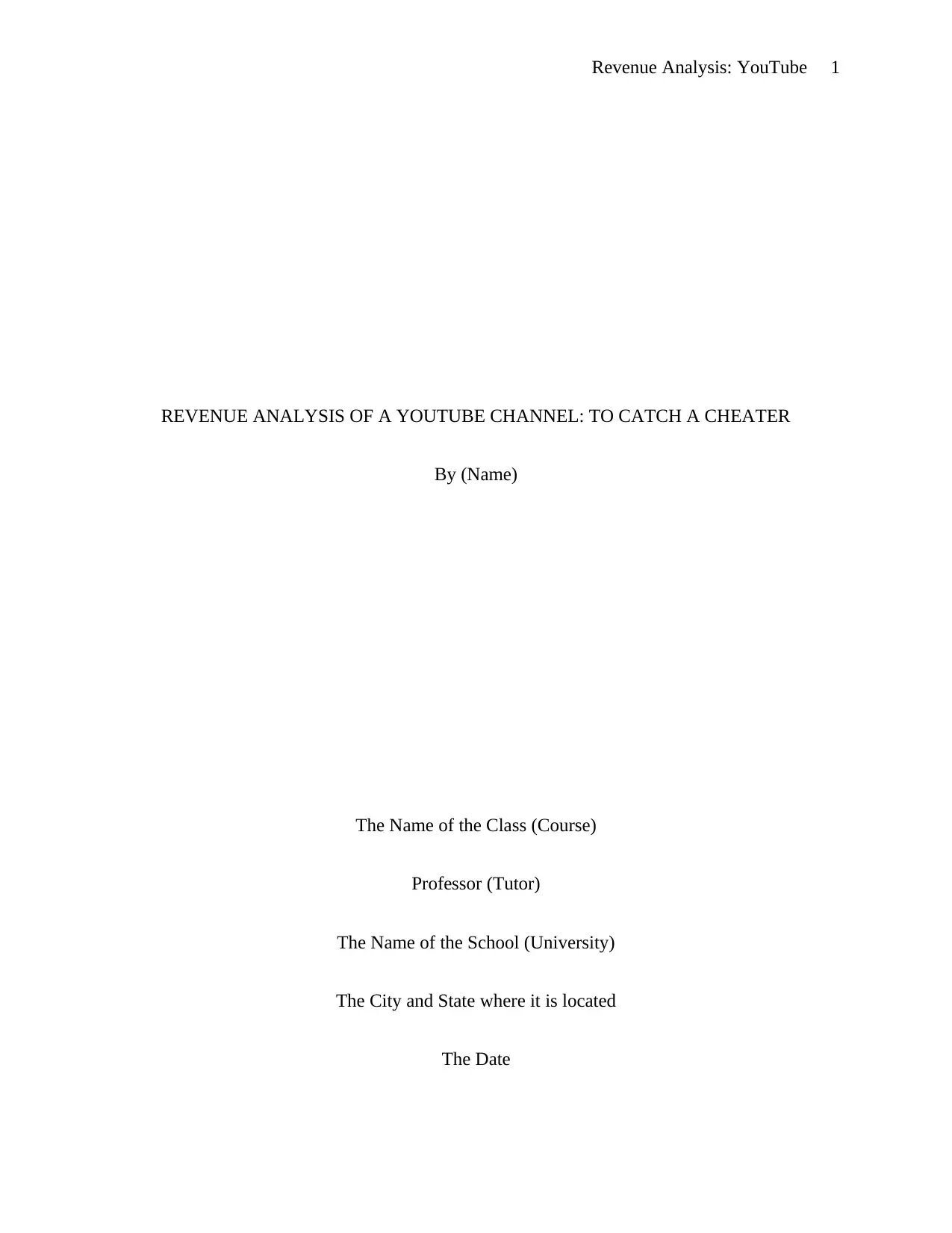
Revenue Analysis: YouTube 1
REVENUE ANALYSIS OF A YOUTUBE CHANNEL: TO CATCH A CHEATER
By (Name)
The Name of the Class (Course)
Professor (Tutor)
The Name of the School (University)
The City and State where it is located
The Date
REVENUE ANALYSIS OF A YOUTUBE CHANNEL: TO CATCH A CHEATER
By (Name)
The Name of the Class (Course)
Professor (Tutor)
The Name of the School (University)
The City and State where it is located
The Date
Paraphrase This Document
Need a fresh take? Get an instant paraphrase of this document with our AI Paraphraser
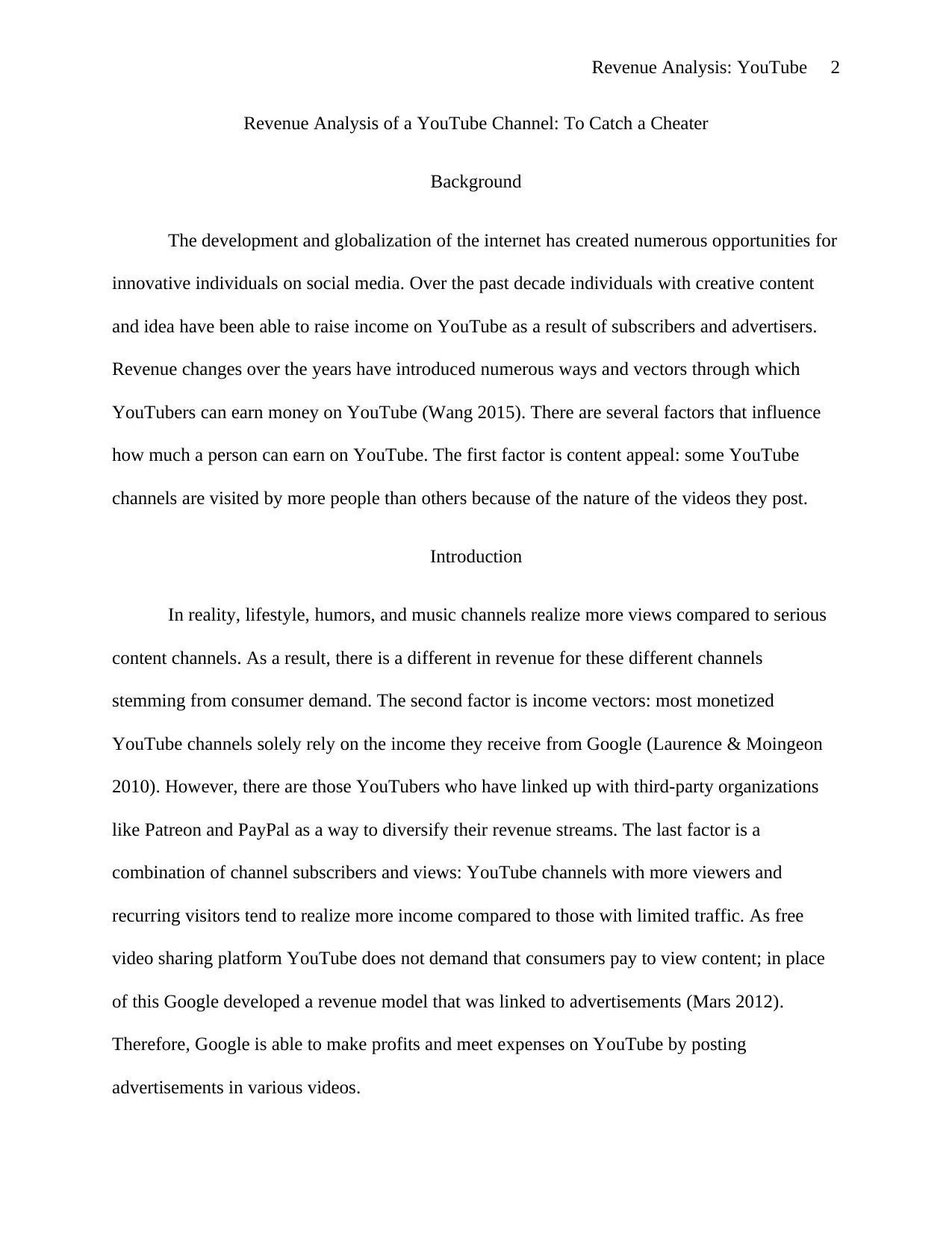
Revenue Analysis: YouTube 2
Revenue Analysis of a YouTube Channel: To Catch a Cheater
Background
The development and globalization of the internet has created numerous opportunities for
innovative individuals on social media. Over the past decade individuals with creative content
and idea have been able to raise income on YouTube as a result of subscribers and advertisers.
Revenue changes over the years have introduced numerous ways and vectors through which
YouTubers can earn money on YouTube (Wang 2015). There are several factors that influence
how much a person can earn on YouTube. The first factor is content appeal: some YouTube
channels are visited by more people than others because of the nature of the videos they post.
Introduction
In reality, lifestyle, humors, and music channels realize more views compared to serious
content channels. As a result, there is a different in revenue for these different channels
stemming from consumer demand. The second factor is income vectors: most monetized
YouTube channels solely rely on the income they receive from Google (Laurence & Moingeon
2010). However, there are those YouTubers who have linked up with third-party organizations
like Patreon and PayPal as a way to diversify their revenue streams. The last factor is a
combination of channel subscribers and views: YouTube channels with more viewers and
recurring visitors tend to realize more income compared to those with limited traffic. As free
video sharing platform YouTube does not demand that consumers pay to view content; in place
of this Google developed a revenue model that was linked to advertisements (Mars 2012).
Therefore, Google is able to make profits and meet expenses on YouTube by posting
advertisements in various videos.
Revenue Analysis of a YouTube Channel: To Catch a Cheater
Background
The development and globalization of the internet has created numerous opportunities for
innovative individuals on social media. Over the past decade individuals with creative content
and idea have been able to raise income on YouTube as a result of subscribers and advertisers.
Revenue changes over the years have introduced numerous ways and vectors through which
YouTubers can earn money on YouTube (Wang 2015). There are several factors that influence
how much a person can earn on YouTube. The first factor is content appeal: some YouTube
channels are visited by more people than others because of the nature of the videos they post.
Introduction
In reality, lifestyle, humors, and music channels realize more views compared to serious
content channels. As a result, there is a different in revenue for these different channels
stemming from consumer demand. The second factor is income vectors: most monetized
YouTube channels solely rely on the income they receive from Google (Laurence & Moingeon
2010). However, there are those YouTubers who have linked up with third-party organizations
like Patreon and PayPal as a way to diversify their revenue streams. The last factor is a
combination of channel subscribers and views: YouTube channels with more viewers and
recurring visitors tend to realize more income compared to those with limited traffic. As free
video sharing platform YouTube does not demand that consumers pay to view content; in place
of this Google developed a revenue model that was linked to advertisements (Mars 2012).
Therefore, Google is able to make profits and meet expenses on YouTube by posting
advertisements in various videos.
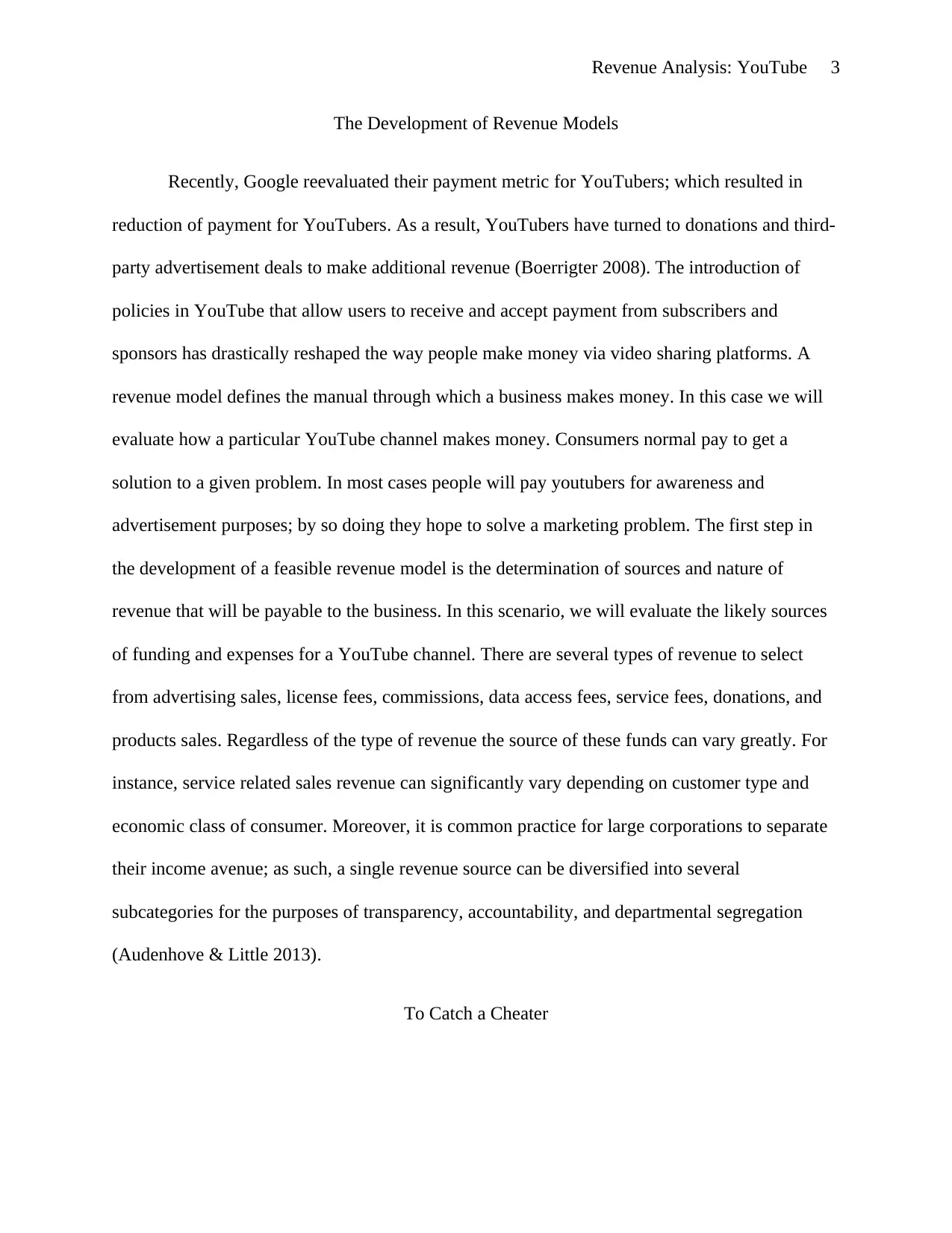
Revenue Analysis: YouTube 3
The Development of Revenue Models
Recently, Google reevaluated their payment metric for YouTubers; which resulted in
reduction of payment for YouTubers. As a result, YouTubers have turned to donations and third-
party advertisement deals to make additional revenue (Boerrigter 2008). The introduction of
policies in YouTube that allow users to receive and accept payment from subscribers and
sponsors has drastically reshaped the way people make money via video sharing platforms. A
revenue model defines the manual through which a business makes money. In this case we will
evaluate how a particular YouTube channel makes money. Consumers normal pay to get a
solution to a given problem. In most cases people will pay youtubers for awareness and
advertisement purposes; by so doing they hope to solve a marketing problem. The first step in
the development of a feasible revenue model is the determination of sources and nature of
revenue that will be payable to the business. In this scenario, we will evaluate the likely sources
of funding and expenses for a YouTube channel. There are several types of revenue to select
from advertising sales, license fees, commissions, data access fees, service fees, donations, and
products sales. Regardless of the type of revenue the source of these funds can vary greatly. For
instance, service related sales revenue can significantly vary depending on customer type and
economic class of consumer. Moreover, it is common practice for large corporations to separate
their income avenue; as such, a single revenue source can be diversified into several
subcategories for the purposes of transparency, accountability, and departmental segregation
(Audenhove & Little 2013).
To Catch a Cheater
The Development of Revenue Models
Recently, Google reevaluated their payment metric for YouTubers; which resulted in
reduction of payment for YouTubers. As a result, YouTubers have turned to donations and third-
party advertisement deals to make additional revenue (Boerrigter 2008). The introduction of
policies in YouTube that allow users to receive and accept payment from subscribers and
sponsors has drastically reshaped the way people make money via video sharing platforms. A
revenue model defines the manual through which a business makes money. In this case we will
evaluate how a particular YouTube channel makes money. Consumers normal pay to get a
solution to a given problem. In most cases people will pay youtubers for awareness and
advertisement purposes; by so doing they hope to solve a marketing problem. The first step in
the development of a feasible revenue model is the determination of sources and nature of
revenue that will be payable to the business. In this scenario, we will evaluate the likely sources
of funding and expenses for a YouTube channel. There are several types of revenue to select
from advertising sales, license fees, commissions, data access fees, service fees, donations, and
products sales. Regardless of the type of revenue the source of these funds can vary greatly. For
instance, service related sales revenue can significantly vary depending on customer type and
economic class of consumer. Moreover, it is common practice for large corporations to separate
their income avenue; as such, a single revenue source can be diversified into several
subcategories for the purposes of transparency, accountability, and departmental segregation
(Audenhove & Little 2013).
To Catch a Cheater
⊘ This is a preview!⊘
Do you want full access?
Subscribe today to unlock all pages.

Trusted by 1+ million students worldwide
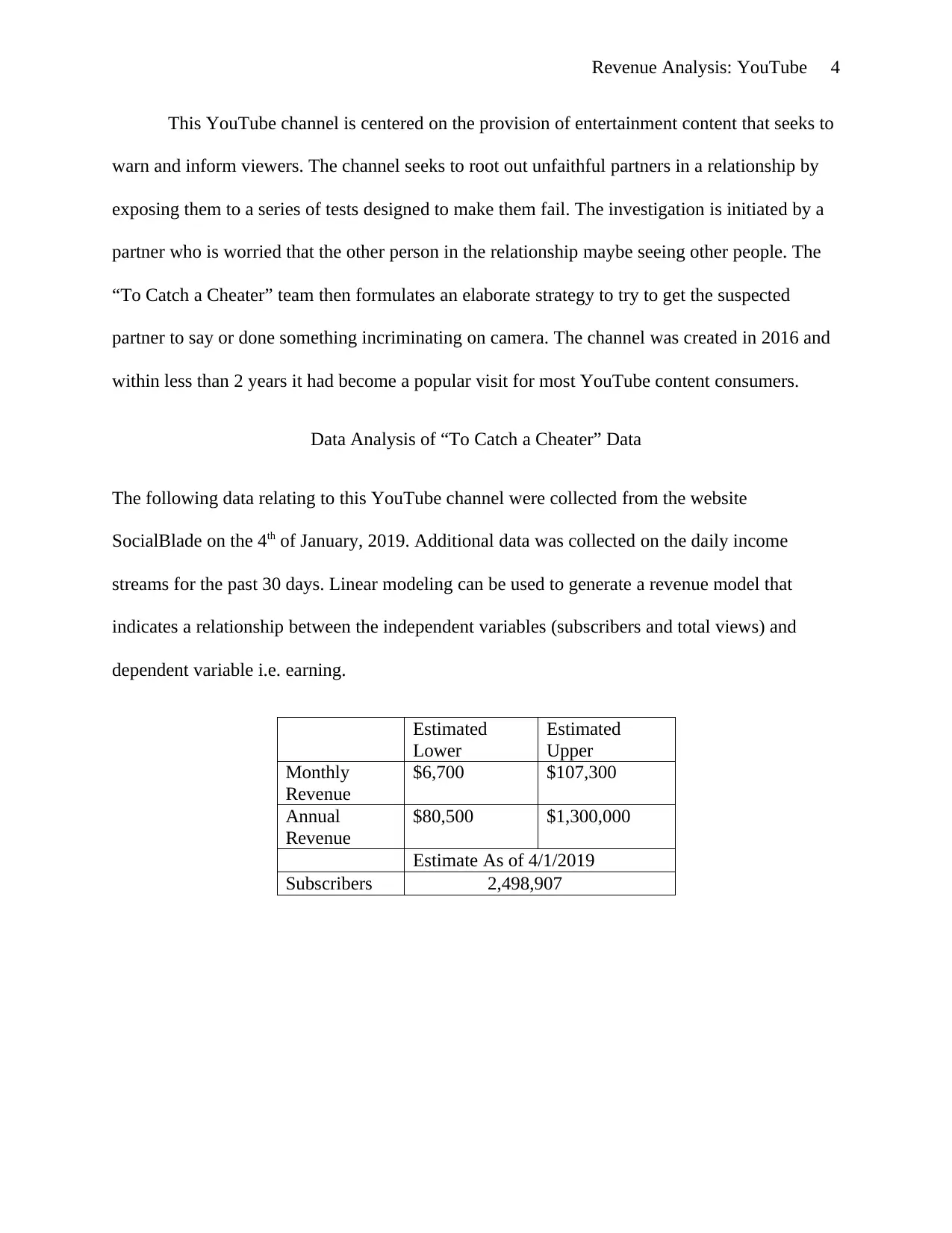
Revenue Analysis: YouTube 4
This YouTube channel is centered on the provision of entertainment content that seeks to
warn and inform viewers. The channel seeks to root out unfaithful partners in a relationship by
exposing them to a series of tests designed to make them fail. The investigation is initiated by a
partner who is worried that the other person in the relationship maybe seeing other people. The
“To Catch a Cheater” team then formulates an elaborate strategy to try to get the suspected
partner to say or done something incriminating on camera. The channel was created in 2016 and
within less than 2 years it had become a popular visit for most YouTube content consumers.
Data Analysis of “To Catch a Cheater” Data
The following data relating to this YouTube channel were collected from the website
SocialBlade on the 4th of January, 2019. Additional data was collected on the daily income
streams for the past 30 days. Linear modeling can be used to generate a revenue model that
indicates a relationship between the independent variables (subscribers and total views) and
dependent variable i.e. earning.
Estimated
Lower
Estimated
Upper
Monthly
Revenue
$6,700 $107,300
Annual
Revenue
$80,500 $1,300,000
Estimate As of 4/1/2019
Subscribers 2,498,907
This YouTube channel is centered on the provision of entertainment content that seeks to
warn and inform viewers. The channel seeks to root out unfaithful partners in a relationship by
exposing them to a series of tests designed to make them fail. The investigation is initiated by a
partner who is worried that the other person in the relationship maybe seeing other people. The
“To Catch a Cheater” team then formulates an elaborate strategy to try to get the suspected
partner to say or done something incriminating on camera. The channel was created in 2016 and
within less than 2 years it had become a popular visit for most YouTube content consumers.
Data Analysis of “To Catch a Cheater” Data
The following data relating to this YouTube channel were collected from the website
SocialBlade on the 4th of January, 2019. Additional data was collected on the daily income
streams for the past 30 days. Linear modeling can be used to generate a revenue model that
indicates a relationship between the independent variables (subscribers and total views) and
dependent variable i.e. earning.
Estimated
Lower
Estimated
Upper
Monthly
Revenue
$6,700 $107,300
Annual
Revenue
$80,500 $1,300,000
Estimate As of 4/1/2019
Subscribers 2,498,907
Paraphrase This Document
Need a fresh take? Get an instant paraphrase of this document with our AI Paraphraser
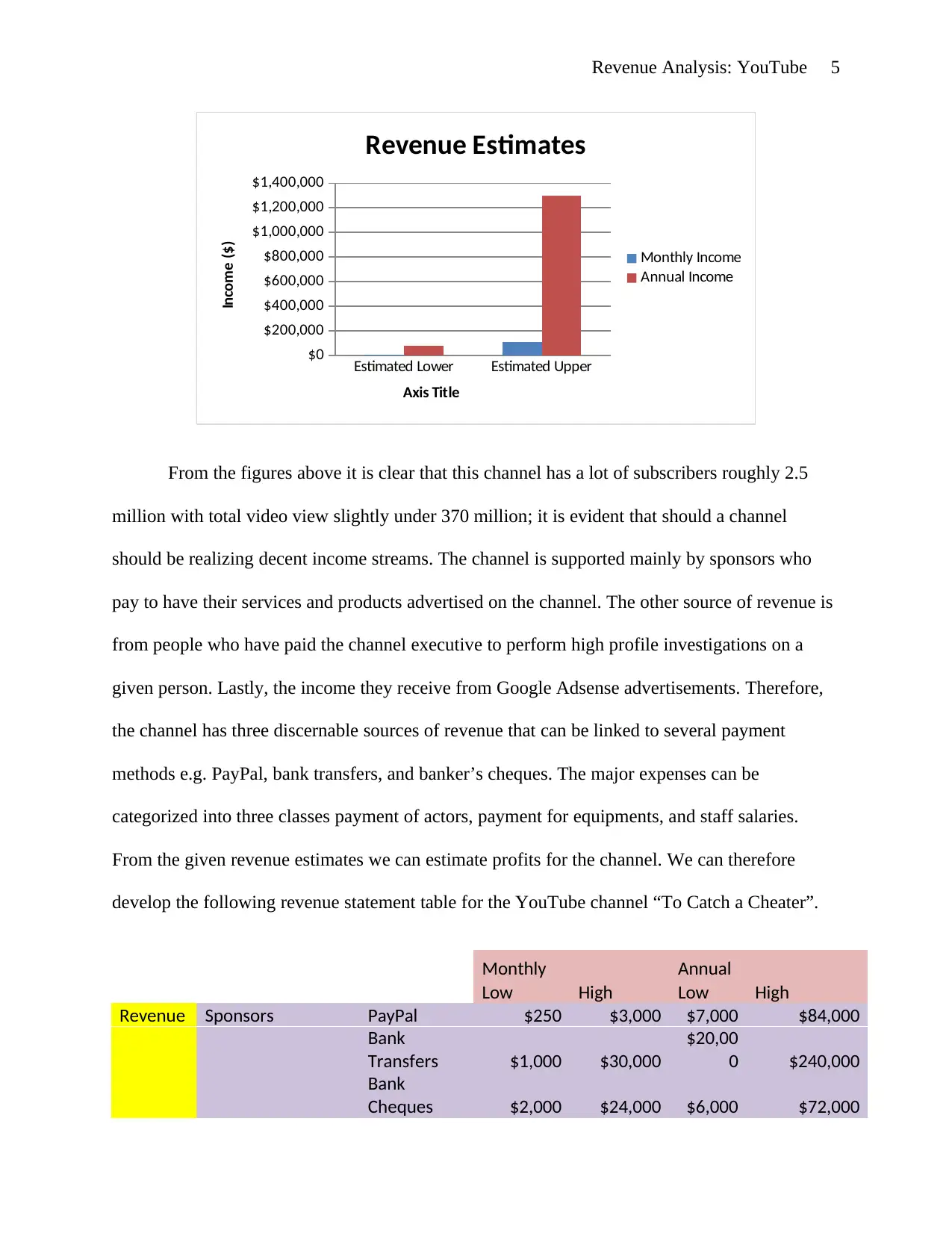
Revenue Analysis: YouTube 5
Estimated Lower Estimated Upper
$0
$200,000
$400,000
$600,000
$800,000
$1,000,000
$1,200,000
$1,400,000
Revenue Estimates
Monthly Income
Annual Income
Axis Title
Income ($)
From the figures above it is clear that this channel has a lot of subscribers roughly 2.5
million with total video view slightly under 370 million; it is evident that should a channel
should be realizing decent income streams. The channel is supported mainly by sponsors who
pay to have their services and products advertised on the channel. The other source of revenue is
from people who have paid the channel executive to perform high profile investigations on a
given person. Lastly, the income they receive from Google Adsense advertisements. Therefore,
the channel has three discernable sources of revenue that can be linked to several payment
methods e.g. PayPal, bank transfers, and banker’s cheques. The major expenses can be
categorized into three classes payment of actors, payment for equipments, and staff salaries.
From the given revenue estimates we can estimate profits for the channel. We can therefore
develop the following revenue statement table for the YouTube channel “To Catch a Cheater”.
Monthly Annual
Low High Low High
Revenue Sponsors PayPal $250 $3,000 $7,000 $84,000
Bank
Transfers $1,000 $30,000
$20,00
0 $240,000
Bank
Cheques $2,000 $24,000 $6,000 $72,000
Estimated Lower Estimated Upper
$0
$200,000
$400,000
$600,000
$800,000
$1,000,000
$1,200,000
$1,400,000
Revenue Estimates
Monthly Income
Annual Income
Axis Title
Income ($)
From the figures above it is clear that this channel has a lot of subscribers roughly 2.5
million with total video view slightly under 370 million; it is evident that should a channel
should be realizing decent income streams. The channel is supported mainly by sponsors who
pay to have their services and products advertised on the channel. The other source of revenue is
from people who have paid the channel executive to perform high profile investigations on a
given person. Lastly, the income they receive from Google Adsense advertisements. Therefore,
the channel has three discernable sources of revenue that can be linked to several payment
methods e.g. PayPal, bank transfers, and banker’s cheques. The major expenses can be
categorized into three classes payment of actors, payment for equipments, and staff salaries.
From the given revenue estimates we can estimate profits for the channel. We can therefore
develop the following revenue statement table for the YouTube channel “To Catch a Cheater”.
Monthly Annual
Low High Low High
Revenue Sponsors PayPal $250 $3,000 $7,000 $84,000
Bank
Transfers $1,000 $30,000
$20,00
0 $240,000
Bank
Cheques $2,000 $24,000 $6,000 $72,000
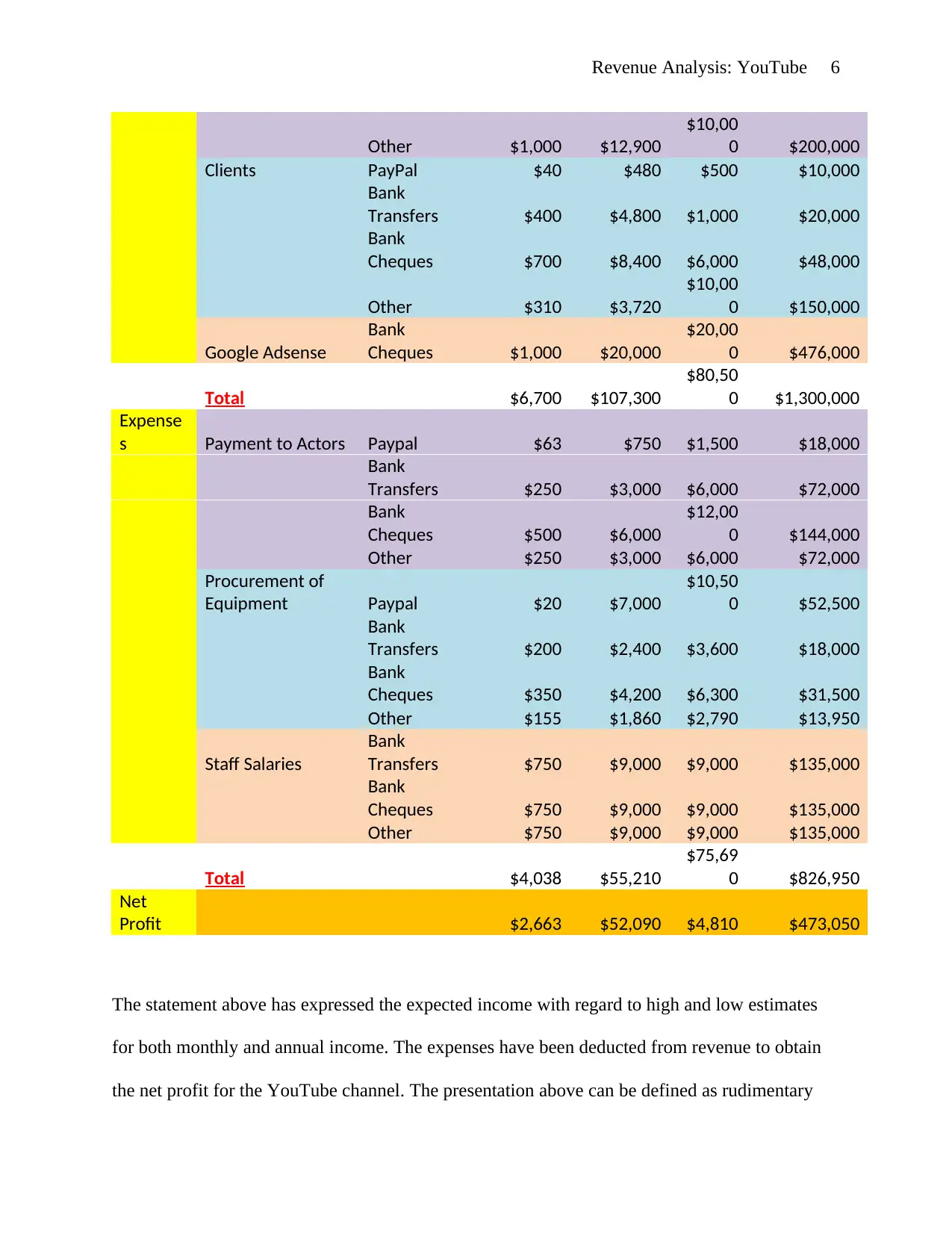
Revenue Analysis: YouTube 6
Other $1,000 $12,900
$10,00
0 $200,000
Clients PayPal $40 $480 $500 $10,000
Bank
Transfers $400 $4,800 $1,000 $20,000
Bank
Cheques $700 $8,400 $6,000 $48,000
Other $310 $3,720
$10,00
0 $150,000
Google Adsense
Bank
Cheques $1,000 $20,000
$20,00
0 $476,000
Total $6,700 $107,300
$80,50
0 $1,300,000
Expense
s Payment to Actors Paypal $63 $750 $1,500 $18,000
Bank
Transfers $250 $3,000 $6,000 $72,000
Bank
Cheques $500 $6,000
$12,00
0 $144,000
Other $250 $3,000 $6,000 $72,000
Procurement of
Equipment Paypal $20 $7,000
$10,50
0 $52,500
Bank
Transfers $200 $2,400 $3,600 $18,000
Bank
Cheques $350 $4,200 $6,300 $31,500
Other $155 $1,860 $2,790 $13,950
Staff Salaries
Bank
Transfers $750 $9,000 $9,000 $135,000
Bank
Cheques $750 $9,000 $9,000 $135,000
Other $750 $9,000 $9,000 $135,000
Total $4,038 $55,210
$75,69
0 $826,950
Net
Profit $2,663 $52,090 $4,810 $473,050
The statement above has expressed the expected income with regard to high and low estimates
for both monthly and annual income. The expenses have been deducted from revenue to obtain
the net profit for the YouTube channel. The presentation above can be defined as rudimentary
Other $1,000 $12,900
$10,00
0 $200,000
Clients PayPal $40 $480 $500 $10,000
Bank
Transfers $400 $4,800 $1,000 $20,000
Bank
Cheques $700 $8,400 $6,000 $48,000
Other $310 $3,720
$10,00
0 $150,000
Google Adsense
Bank
Cheques $1,000 $20,000
$20,00
0 $476,000
Total $6,700 $107,300
$80,50
0 $1,300,000
Expense
s Payment to Actors Paypal $63 $750 $1,500 $18,000
Bank
Transfers $250 $3,000 $6,000 $72,000
Bank
Cheques $500 $6,000
$12,00
0 $144,000
Other $250 $3,000 $6,000 $72,000
Procurement of
Equipment Paypal $20 $7,000
$10,50
0 $52,500
Bank
Transfers $200 $2,400 $3,600 $18,000
Bank
Cheques $350 $4,200 $6,300 $31,500
Other $155 $1,860 $2,790 $13,950
Staff Salaries
Bank
Transfers $750 $9,000 $9,000 $135,000
Bank
Cheques $750 $9,000 $9,000 $135,000
Other $750 $9,000 $9,000 $135,000
Total $4,038 $55,210
$75,69
0 $826,950
Net
Profit $2,663 $52,090 $4,810 $473,050
The statement above has expressed the expected income with regard to high and low estimates
for both monthly and annual income. The expenses have been deducted from revenue to obtain
the net profit for the YouTube channel. The presentation above can be defined as rudimentary
⊘ This is a preview!⊘
Do you want full access?
Subscribe today to unlock all pages.

Trusted by 1+ million students worldwide
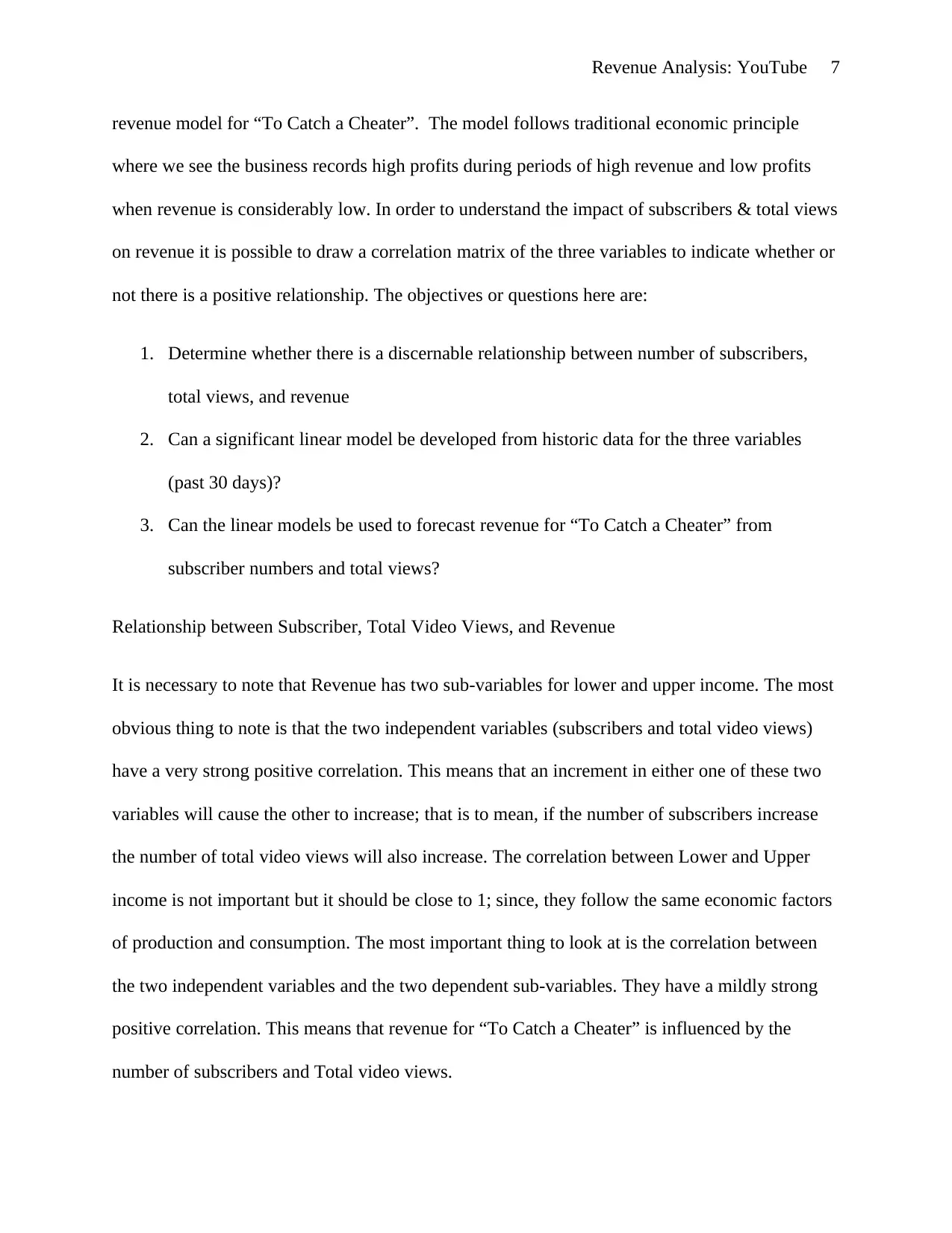
Revenue Analysis: YouTube 7
revenue model for “To Catch a Cheater”. The model follows traditional economic principle
where we see the business records high profits during periods of high revenue and low profits
when revenue is considerably low. In order to understand the impact of subscribers & total views
on revenue it is possible to draw a correlation matrix of the three variables to indicate whether or
not there is a positive relationship. The objectives or questions here are:
1. Determine whether there is a discernable relationship between number of subscribers,
total views, and revenue
2. Can a significant linear model be developed from historic data for the three variables
(past 30 days)?
3. Can the linear models be used to forecast revenue for “To Catch a Cheater” from
subscriber numbers and total views?
Relationship between Subscriber, Total Video Views, and Revenue
It is necessary to note that Revenue has two sub-variables for lower and upper income. The most
obvious thing to note is that the two independent variables (subscribers and total video views)
have a very strong positive correlation. This means that an increment in either one of these two
variables will cause the other to increase; that is to mean, if the number of subscribers increase
the number of total video views will also increase. The correlation between Lower and Upper
income is not important but it should be close to 1; since, they follow the same economic factors
of production and consumption. The most important thing to look at is the correlation between
the two independent variables and the two dependent sub-variables. They have a mildly strong
positive correlation. This means that revenue for “To Catch a Cheater” is influenced by the
number of subscribers and Total video views.
revenue model for “To Catch a Cheater”. The model follows traditional economic principle
where we see the business records high profits during periods of high revenue and low profits
when revenue is considerably low. In order to understand the impact of subscribers & total views
on revenue it is possible to draw a correlation matrix of the three variables to indicate whether or
not there is a positive relationship. The objectives or questions here are:
1. Determine whether there is a discernable relationship between number of subscribers,
total views, and revenue
2. Can a significant linear model be developed from historic data for the three variables
(past 30 days)?
3. Can the linear models be used to forecast revenue for “To Catch a Cheater” from
subscriber numbers and total views?
Relationship between Subscriber, Total Video Views, and Revenue
It is necessary to note that Revenue has two sub-variables for lower and upper income. The most
obvious thing to note is that the two independent variables (subscribers and total video views)
have a very strong positive correlation. This means that an increment in either one of these two
variables will cause the other to increase; that is to mean, if the number of subscribers increase
the number of total video views will also increase. The correlation between Lower and Upper
income is not important but it should be close to 1; since, they follow the same economic factors
of production and consumption. The most important thing to look at is the correlation between
the two independent variables and the two dependent sub-variables. They have a mildly strong
positive correlation. This means that revenue for “To Catch a Cheater” is influenced by the
number of subscribers and Total video views.
Paraphrase This Document
Need a fresh take? Get an instant paraphrase of this document with our AI Paraphraser
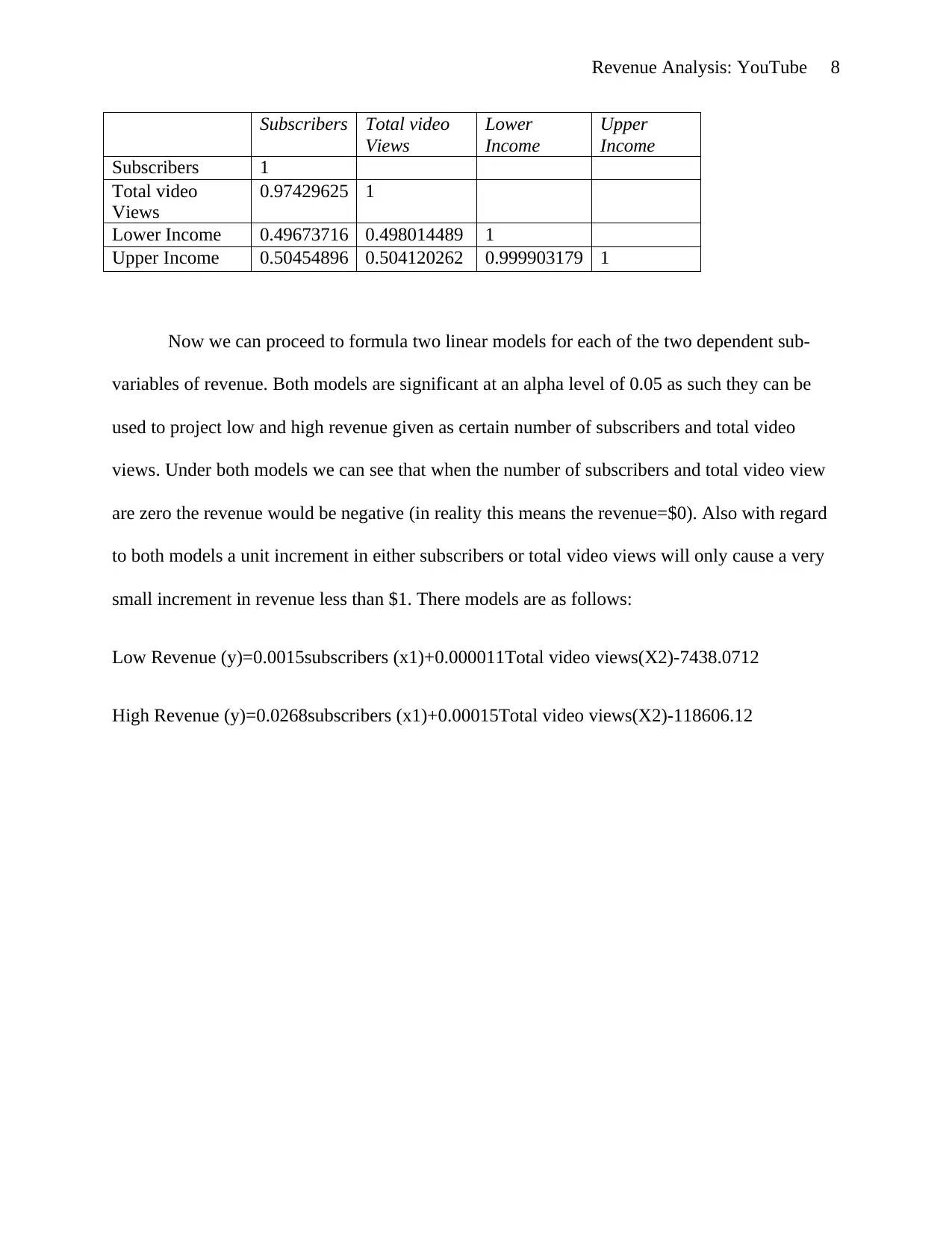
Revenue Analysis: YouTube 8
Subscribers Total video
Views
Lower
Income
Upper
Income
Subscribers 1
Total video
Views
0.97429625 1
Lower Income 0.49673716 0.498014489 1
Upper Income 0.50454896 0.504120262 0.999903179 1
Now we can proceed to formula two linear models for each of the two dependent sub-
variables of revenue. Both models are significant at an alpha level of 0.05 as such they can be
used to project low and high revenue given as certain number of subscribers and total video
views. Under both models we can see that when the number of subscribers and total video view
are zero the revenue would be negative (in reality this means the revenue=$0). Also with regard
to both models a unit increment in either subscribers or total video views will only cause a very
small increment in revenue less than $1. There models are as follows:
Low Revenue (y)=0.0015subscribers (x1)+0.000011Total video views(X2)-7438.0712
High Revenue (y)=0.0268subscribers (x1)+0.00015Total video views(X2)-118606.12
Subscribers Total video
Views
Lower
Income
Upper
Income
Subscribers 1
Total video
Views
0.97429625 1
Lower Income 0.49673716 0.498014489 1
Upper Income 0.50454896 0.504120262 0.999903179 1
Now we can proceed to formula two linear models for each of the two dependent sub-
variables of revenue. Both models are significant at an alpha level of 0.05 as such they can be
used to project low and high revenue given as certain number of subscribers and total video
views. Under both models we can see that when the number of subscribers and total video view
are zero the revenue would be negative (in reality this means the revenue=$0). Also with regard
to both models a unit increment in either subscribers or total video views will only cause a very
small increment in revenue less than $1. There models are as follows:
Low Revenue (y)=0.0015subscribers (x1)+0.000011Total video views(X2)-7438.0712
High Revenue (y)=0.0268subscribers (x1)+0.00015Total video views(X2)-118606.12
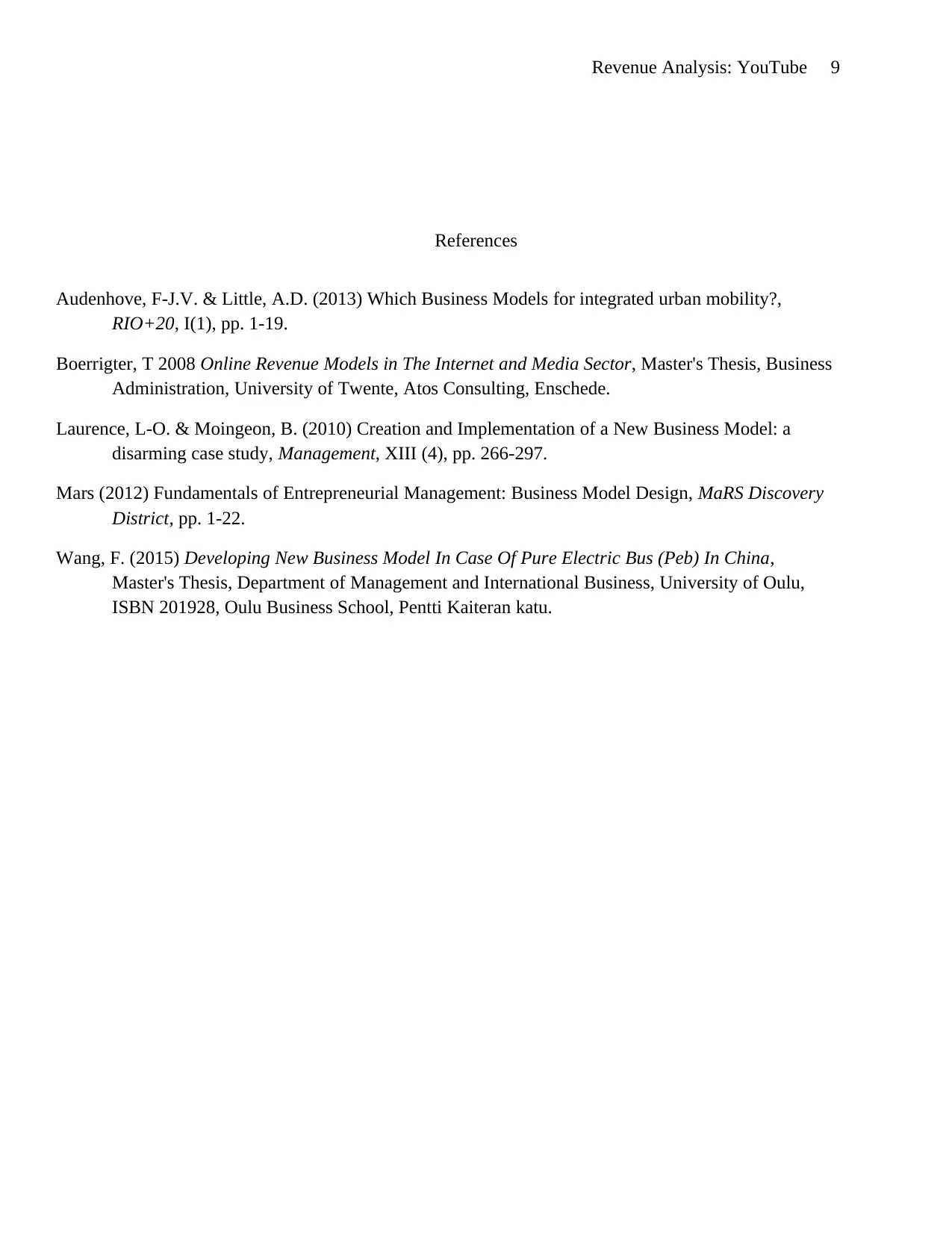
Revenue Analysis: YouTube 9
References
Audenhove, F-J.V. & Little, A.D. (2013) Which Business Models for integrated urban mobility?,
RIO+20, I(1), pp. 1-19.
Boerrigter, T 2008 Online Revenue Models in The Internet and Media Sector, Master's Thesis, Business
Administration, University of Twente, Atos Consulting, Enschede.
Laurence, L-O. & Moingeon, B. (2010) Creation and Implementation of a New Business Model: a
disarming case study, Management, XIII (4), pp. 266-297.
Mars (2012) Fundamentals of Entrepreneurial Management: Business Model Design, MaRS Discovery
District, pp. 1-22.
Wang, F. (2015) Developing New Business Model In Case Of Pure Electric Bus (Peb) In China,
Master's Thesis, Department of Management and International Business, University of Oulu,
ISBN 201928, Oulu Business School, Pentti Kaiteran katu.
References
Audenhove, F-J.V. & Little, A.D. (2013) Which Business Models for integrated urban mobility?,
RIO+20, I(1), pp. 1-19.
Boerrigter, T 2008 Online Revenue Models in The Internet and Media Sector, Master's Thesis, Business
Administration, University of Twente, Atos Consulting, Enschede.
Laurence, L-O. & Moingeon, B. (2010) Creation and Implementation of a New Business Model: a
disarming case study, Management, XIII (4), pp. 266-297.
Mars (2012) Fundamentals of Entrepreneurial Management: Business Model Design, MaRS Discovery
District, pp. 1-22.
Wang, F. (2015) Developing New Business Model In Case Of Pure Electric Bus (Peb) In China,
Master's Thesis, Department of Management and International Business, University of Oulu,
ISBN 201928, Oulu Business School, Pentti Kaiteran katu.
⊘ This is a preview!⊘
Do you want full access?
Subscribe today to unlock all pages.

Trusted by 1+ million students worldwide
1 out of 9
Related Documents
Your All-in-One AI-Powered Toolkit for Academic Success.
+13062052269
info@desklib.com
Available 24*7 on WhatsApp / Email
![[object Object]](/_next/static/media/star-bottom.7253800d.svg)
Unlock your academic potential
Copyright © 2020–2025 A2Z Services. All Rights Reserved. Developed and managed by ZUCOL.

